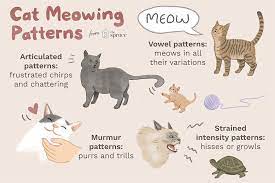Even though your cat can’t speak your language, she does her best to try to communicate with you. In this post, you will receive a possible translation of a few of your cat’s sounds. Perhaps this information will help you reach a greater understanding of your cat. So, what is the meaning of cat sounds?
Cats Can Tend To Be A Vocal Bunch
Cats can make over 100 sounds, so you will get translations of just a smattering of the vocalizations they can make. However, once you know the basics, it may become easier for you to translate into English.
Of course, if you have a very vocal cat, you may need to write a new dictionary. That might well be the case with Mocha, my present cat. He seems rather unusual when it comes to cat language.

The only time he actually meows occurs when I prepare his meal and he feels I’m taking too long. His everyday communication is done with trills (I guess that’s what you call them — sort of a high-pitched brrr sound.) He greets me this way and at times carries on little conversations using this sound.
However, at times he seems to be trying to speak in our language. He comes out with what appears to be whole sentences, and I can’t translate them fully. He certainly does use some variety in his speech!
BASIC CAT SOUNDS
Okay, so what are a few of the basic sounds we hear? Let’s look at some of the most common ones.
The Classic Meow
This sound must rank as the most common cat sound — it’s one we have all heard, sometimes more than we wish. The cat uses the meow mostly to communicate with us humans. In the cat world, kittens meow to tell their mother she is needed, but this tendency to meow to another cat tends to disappear.
Occasionally a cat will meow at another cat, usually as a form of greeting, but once the cat grows up, most of these meows are reserved for humans.
The meow indicates the cat wants something. Most often, he’s asking for dinner. This meow is usually uttered in mid-pitch and mid-length in duration. Meows can differ in pitch; for example, a high-pitched yelp might occur if you step on the cat’s tail. The sound can be low-pitched if the cat wants to complain about something: for example, dinner is past due and the bowl is empty.

Repeated meows might indicate that your cat is excited. Once I had to go to Juneau for the day, and asked a friend to come and feed my cat, Carlos, while I was gone. She forgot.
When I came home the next day, the cat met me at the door, and made non-stop meows until I got inside and realized he wanted to be fed. Poor kitty! He found a bag of cereal on the kitchen counter, pulled it down to the floor, and ate some of it. He also pushed the butter dish to the floor and licked a little of it. I fed him right away.
We All Love The Purr
This rumbling sound can melt your heart. It can also help you relax and de-stress, and it most likely does the same thing for your cat. When the cat purrs, it often signifies that he is content and happy.
The cat purring in your bed can help bring on sleep. It’s such a soothing sound. Most often, it comes across as a sign of cat contentment. But, at times it can have other meanings.
When a cat becomes sick or is in pain, he will often purr to soothe himself. Also, it’s been shown that the cat purr can help heal broken bones. Thus, you can interpret the cause of the purr easily by observing the circumstances in which it occurs. At any rate, the purr ranks as a force for good.
Hissing
When you hear this sound coming from your cat, you know that the cat has become upset. He may feel threatened and ready to fight if he must. When you hear that sound, it’s not from a snake, but from an agitated cat. Better take it as a warning and back off.
Along with hearing the hiss, observe the cat’s body language, such as arched back, fur all puffed out, tail twitching, ears flattened, fangs bared. Watch out! If your cat becomes very upset by something, he may go into attack mode.
Perhaps your cat has led a calm, sheltered life, and does not have “hissy fits.” If your cat was abused, a stray, or feral, that cat becomes much more likely to hiss.
Growling Or Snarling
These sounds may often accompany the hiss and can indicate a number of things. Perhaps the cat experiences fear or anger, as over a territorial threat. This growl could escalate into a yowl. At such times you’d best make a wide detour around that stressed-out animal.
Yowling
This sound is a long-drawn-out meow indicating a number of things. It could mean worry, discomfort, concerns about territory, or mating issues.
If the yowl goes on continuously, it’s time to see the vet. Or, the yowl might indicate a message to another cat, perhaps signifying the desire to mate, or ordering the intruder off his turf. Often this sound occurs just before a cat fight.

Caterwauling
I love that word! However, the sound that goes with the word will not be pleasant to the ears. It’s a shrill, wailing sound that might make you think your cat experiences pain. Nope. She is in heat.
The female, or “Queen,” utters this sound to let prospective suitors to know that she is ready to mate. Meanwhile, she does get the desired results if there are any males nearby. They will flock to her doorstep, and then argue over who gets to mate with her.
Chirps, Trills, And Chatters
The cat learns these sounds as a kitten, as Mama Cat uses them to tell kittens to pay attention or to follow her. Your cat may then use those sounds to get your attention. Usually these sounds indicate your cat is happy or excited.
In Kodiak, when Tiger, the neighbor cat and Carlos’s best friend, got injured by a dog, he couldn’t hunt. He’d spend the day at our house, and Carlos would hunt for him. Carlos would bring Tiger a vole and chirp a little love message to his friend when he gave him the gift. So sweet!
The chatter comes from the teeth, and the cat makes this sound when watching birds through the window, and expressing frustration at not being able to get to them.

When you work on interpreting cat sounds, make sure you observe the body language that accompanies them. These will certainly give clues as to what the cat tries to communicate.
Pay attention to your cat — Watch how he behaves, what he likes and doesn’t like, and listen to him with the idea of learning how to better interpret his communication with you.
References I used for this post: petmd.com/cat/slideshows/8-cat-sounds-and-what-they-mean http://weareallaboutcats.com/5-common-cat-noises-and-what-they-mean http://moderncat.com/articles/12-sounds-cats-make-and-what-they-mean/ purina.co.uk/articles/cats/behaviour/understanding-cats/what-do-cat-sounds-mean

